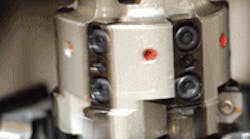If you're in the machine tool business, you know that early iterations of CNC adaptive control leave something to be desired. Most are put into a standalone PLC connected to a machine with intricate wiring that complicates setup and slows response. The controller's analog-velocity output typically goes to a separate drive, which in turn controls a velocity loop to the machine — so interjecting adaptive control in these loops degrades already taxed response time. In addition, feedback loops are not always fully closed — and some early adaptive controls did not require or allow tuning.
In contrast, new-generation CNC-based adaptive controls leverage the speed and performance of drive-and-control combinations by using controls, spindle motor, servomotors, and amplifiers to directly monitor load on the spindle — and optimize cutting feedrates based on these measurements.
Case in point: Adaptive control called iAdaptS from FANUC FA America, Hoffman Estates, Ill., improves material removal and minimizes cycle time by automatically optimizing cutting feedrate based on actual spindle load. iAdaptS compensates for variations in material hardness, tool wear, and depth and width of cut. With this control, users (via G code) set the spindle load per cut; a warning load level, for when load cannot be kept to an acceptable level (which triggers a warning light, automatic machine safemode, or other function); and an ultimate alarm setting (to automatically shut the machine down). FANUC's CNC product manager Joe Donatoni explains, “Adaptive control has been available for some time, but new adaptive controls monitor spindle cutting load and holds it to a user-defined point by adjusting machine feed override. It's much faster than an operator looking at a load meter and adjusting feedrate manually.”
In fact, users interact with a graphing feature that displays both the spindle load and feedrate override versus time. Feedrate control is 100 times finer, to boost responsiveness and accuracy; cycle times are also reduced by up to 40% because every part is optimized in real-time. A torque override feature allows an operator to dynamically modify the adaptive-control setpoint during the machining cycle.iAdaptS also keeps roughing tools fully loaded, putting the heat into the chips rather than the part, thus extending tool life — so there are fewer stoppages.
Adaptive power control for efficiency at light loads
This phase-shifted full-bridge PWM controller allows programmable delays and has an adaptive zero voltage switching (ZVS) control scheme over wide input voltage variations or output load swings — for efficiencies above 90% from light to full load to meet Climate Savers efficiency standards. Called the UCC28950 and manufacturerd by Texas Instruments Inc., Dallas, more information on the device is at ti.com/ucc28950-pr or search at newark.com.
Robotics at FABTECH 2011
North America's largest metal forming, fabricating, finishing, and welding event returns to McCormick Place, Chicago, November 14 to 17. This annual event anticipates over 1,200 exhibiting companies. The majority of robotics will be exhibited in the South Building. For more information, visit fabtechexpo.com.
